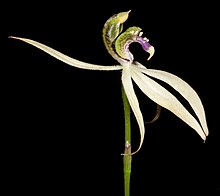Praecoxanthus
| Leafless orchid | |
|---|---|

| |
| Praecoxanthus aphyllus growing near Pinjarra | |
| Scientific classification | |
| Kingdom: | Plantae |
| Clade: | Tracheophytes |
| Clade: | Angiosperms |
| Clade: | Monocots |
| Order: | Asparagales |
| Family: | Orchidaceae |
| Subfamily: | Orchidoideae |
| Tribe: | Diurideae |
| Subtribe: | Caladeniinae |
| Genus: | Praecoxanthus Hopper & A.P.Br. |
| Species: | P. aphyllus |
| Binomial name | |
| Praecoxanthus aphyllus (Benth.) Hopper & A.P.Br. | |
| Synonyms[1] | |
| |
Praecoxanthus aphyllus, commonly known as leafless orchid, is the only species of the flowering plant genus Praecoxanthus in the orchid family, Orchidaceae and is endemic to the south-west of Western Australia. Plants in flower lack a true leaf, although those plants that are not flowering do possess a green leaf. This species is one of the first orchids to flower each year and its creamy white, fragrant flower easily distinguishes it from other species.
Description
Praecoxanthus aphyllus is a terrestrial, perennial, deciduous, sympodial herb with a few inconspicuous, fine roots and a tuber partly surrounded by a fibrous sheath. The tuber produces a replacement "dropper" which becomes the daughter tuber in the following year. Non-flowering plants produce a single, stalkless, egg-shaped leaf which is 20–40 mm (0.8–2 in) long, 8–20 mm (0.3–0.8 in) wide and glabrous with prominent white veins. The leaf of flowering plants is reduced to a tiny bract at the base of the stem.[2][3][4]
There is a single resupinate flower on the end of a wiry, glabrous stem 20–40 cm (8–20 in) high. The flower is 2–4 cm (0.8–2 in) wide and long. The three sepals and two petals are spreading, creamy-white, free and similar in size and shape to each other. As is usual in orchids, one petal is highly modified as the central labellum. The labellum has three lobes and is purple, green and yellow with two irregular rows of stalked, club-like calli. The sexual parts of the flower are fused to the column, which has wing-like structures on its sides and are widest at the base. Flowering occurs from March to May and the fruit that follows is a non-fleshy, hairy, dehiscent capsule containing a large number of seeds.[2][3][4]

Taxonomy and naming
Leafless orchid was first formally described in 1837 by George Bentham who gave it the name Caladenia aphylla and published the description in Flora Australiensis.[5][6] In 2000, Stephen Hopper and Andrew Brown described the genus Praecoxanthus and included this species.[7]
The genus name "Praecoxanthus" is derived from the Latin word praecox meaning "premature" or "precocious"[8]: 629 and the Ancient Greek anthos meaning "flower".[8]: 54 The specific epithet "aphyllus" is derived from the Ancient Greek prefix "a-" meaning "without"[8]: 62 and phyllon meaning "leaf".[8]: 605
Ecology
Leafless orchid flowers are highly fragrant and attract native bees. The yellow calli on a purple labellum resemble pollen-bearing stamens but the flower is nectarless,[4] attracting the insects to an absent reward.[9]
Distribution and habitat
This orchid usually grows in sandy soils in woodland but near Esperance tends to grow in low heath with sub-soil moisture. Unlike some orchids, they do not usually grow in colonies and individuals are well-spaced.[2][10] It occurs between Pinjarra and Albany and in a coastal strip east to Esperance[2] in the Avon Wheatbelt, Esperance Plains, Jarrah Forest, Mallee, Swan Coastal Plain and Warren biogeographic regions.[11][12]
Conservation
Praecoxanthus aphyllus is classified as "Not Threatened" by the Western Australian Government Department of Parks and Wildlife.[11]
References
- ^ "Praecoxanthus". World Checklist of Selected Plant Families (WCSP). Royal Botanic Gardens, Kew. Retrieved 25 June 2016.
- ^ a b c d Hoffman, Noel; Brown, Andrew (2011). Orchids of South-West Australia (3rd ed.). Gooseberry Hill: Noel Hoffman. pp. 210–212. ISBN 9780646562322.
- ^ a b "Praecoxanthus". FloraBase. Western Australian Government Department of Biodiversity, Conservation and Attractions.
- ^ a b c Pridgeon, Alec M.; Cribb, Phillip J.; Chase, Mark W.; Rasmussen, Finn, eds. (2001). Genera Orchidacearum, Volume 2, Orchidoideae (part 1). Oxford, England: Oxford University Press. pp. 113–115. ISBN 0198507100.
- ^ "Caladenia aphylla". APNI. Retrieved 25 June 2016.
- ^ Bentham, George (1837). Flora Australiensis. Vol. 6. London: Lovell Reeve and Co. p. 387. Retrieved 25 June 2016.
- ^ "Praecoxanthus aphyllus". APNI. Retrieved 25 June 2016.
- ^ a b c d Brown, Roland Wilbur (1956). The Composition of Scientific Words. Washington, D.C.: Smithsonian Institution Press.
- ^ Groom, Philip K. Groom; Lamont, Byron (2014). Plant Life of Southwestern Australia Adaptations for Survival. Berlin: De Gruyter. p. 138. ISBN 9783110370164.
- ^ Archer, William (21 July 2008). "Praecoxanthus aphyllus". Esperance Wildflowers. Retrieved 25 June 2016.
- ^ a b "Praecoxanthus aphyllus". FloraBase. Western Australian Government Department of Biodiversity, Conservation and Attractions.
- ^ Paczkowska, Grazyna; Chapman, Alex R. (2000). The Western Australian flora : a descriptive catalogue. Perth: Wildflower Society of Western Australia. p. 87. ISBN 0646402439.
External links
 Media related to Praecoxanthus at Wikimedia Commons
Media related to Praecoxanthus at Wikimedia Commons Data related to Praecoxanthus at Wikispecies
Data related to Praecoxanthus at Wikispecies- C Hookman, Praecoxanthus aphyllus - Leafless Orchid
- Retired Aussies, Praecoxanthus aphyllus - Leafless Orchid
